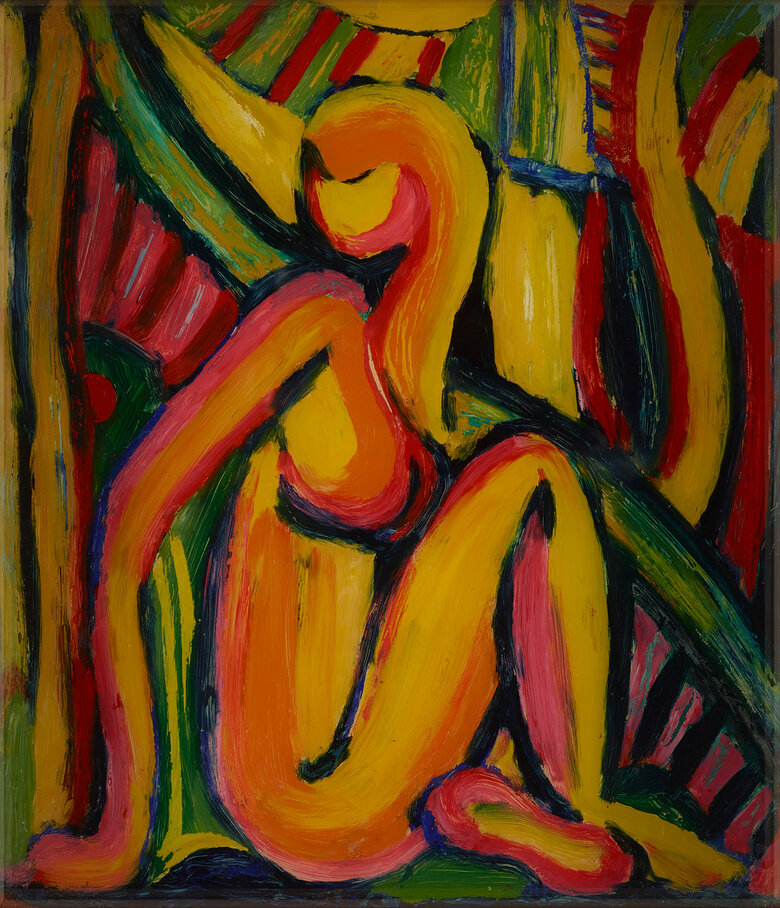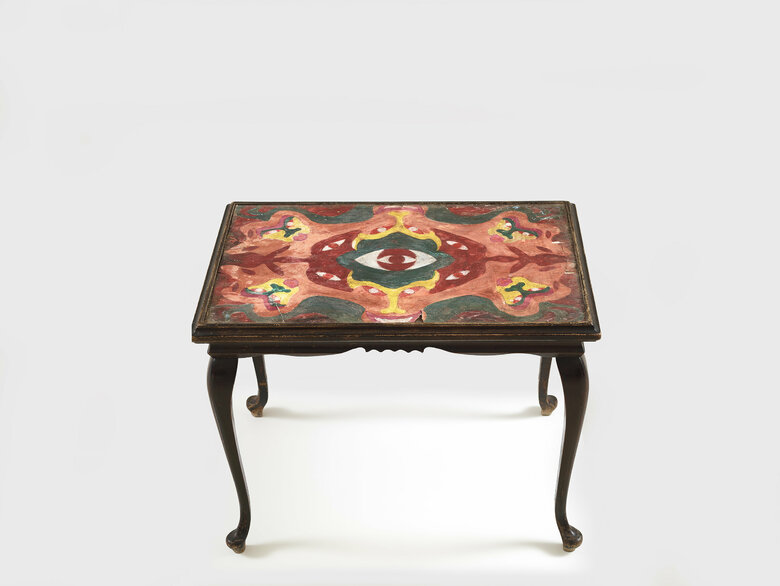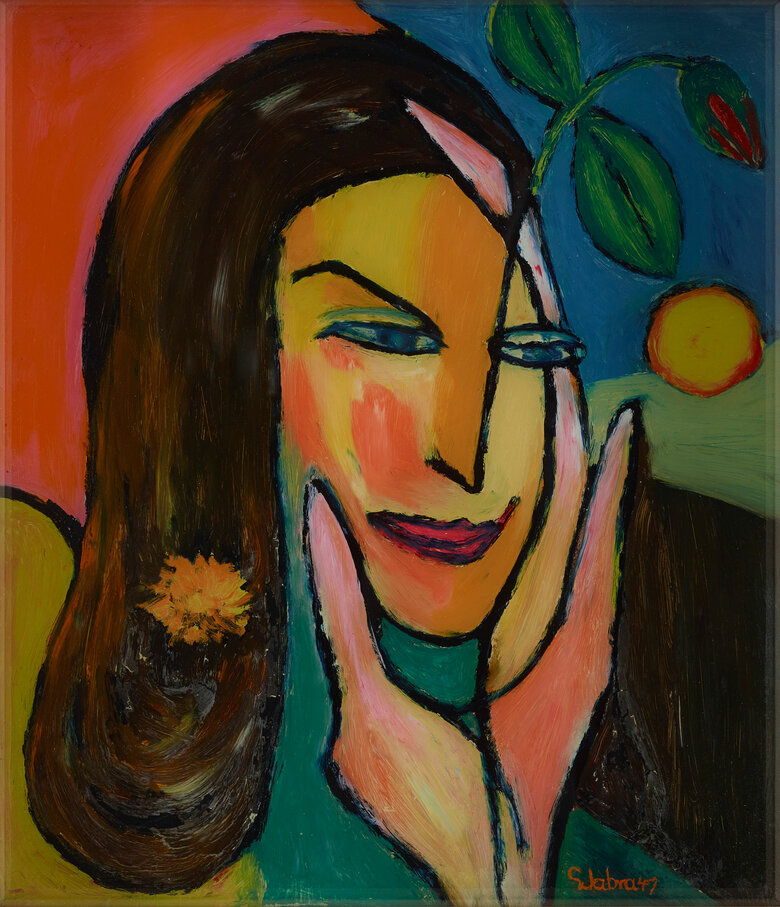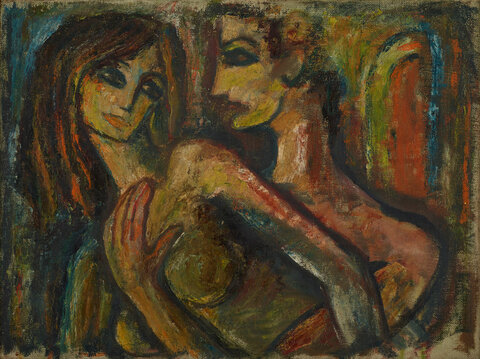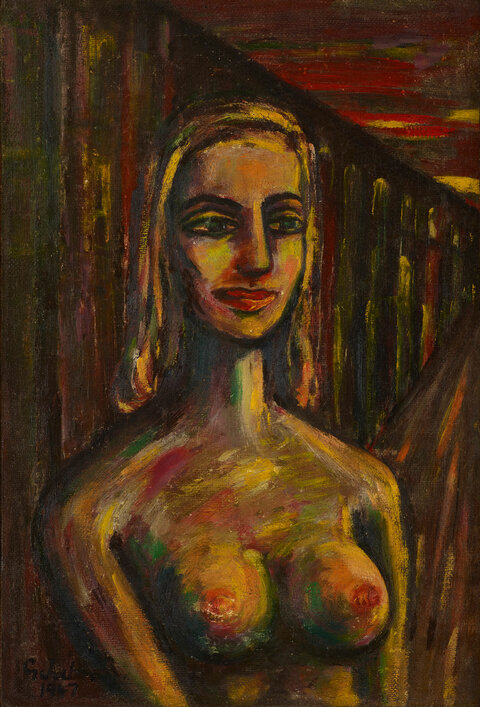Written by Wafa Roz Palestinian-Iraqi artist Jabra Ibrahim Jabra was born into a poor Syriac Orthodox family in Bethlehem in 1920. His family moved to Jerusalem when he was twelve years old, and...
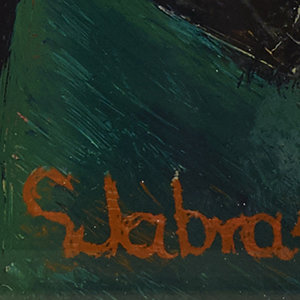

JABRA IBRAHIM JABRA, Palestine (1920 - 1994)
Bio
Written by Wafa Roz
Palestinian-Iraqi artist Jabra Ibrahim Jabra was born into a poor Syriac Orthodox family in Bethlehem in 1920. His family moved to Jerusalem when he was twelve years old, and he attended the Arab College there in preparation for university education. After receiving a scholarship to study in England in 1939, he began a B.A. at the University of Exeter, ultimately completing his degree at Cambridge in 1943. Jabra taught English in Bethlehem for several years, before the Nakba of 1948 forced him and his family to leave Palestine and settle in Iraq, where he would live for the rest of his career. Around this time, he also traveled to the United States, where he earned an MA in literary criticism from Harvard. Upon his return to Iraq, Jabra became a professor of English at the University of Baghdad, later marrying an Iraqi woman, Lami’a Barqi al-‘Askari, and becoming an Iraqi citizen.
Jabra Ibrahim Jabra was a multitalented individual, crossing many disciplinary boundaries throughout his career. In addition to creative pursuits such as painting and poetry, he was a well-respected critic of art and literature as well as a translator. In fact, Jabra was an Arabic translator of many renowned English-language authors, including T.S. Eliot, Shakespeare, Faulkner, and Becket. His own writing – comprising some 70 books – included novels and poetry as well as critical and philosophical works concerning modernism and Arab societies. His interest in this last topic ultimately led him in the direction of Jewad Selim, who became a close friend and colleague. Jabra shared Selim’s passion for thinking through alternative genealogies of the modern, believing as he did that Iraqi modern art can and should be rooted in Arab rather than European source material. He became a founding member of the Baghdad Group for Modern Art (1951) and, later, the One Dimension Group (1971), which espoused a similar commitment to the fusion of modern aesthetics and heritage. Like Selim and fellow One Dimension member Shaker Hassan Al Said, Jabra embraced the principles of hurufiyya, a movement that sought to marry modern abstraction and traditional Arabic calligraphy.
Jabra began his artistic trajectory as a child in Bethlehem. There, as he recounts in his childhood autobiography The First Well, artisans who made intricate mother-of-pearl inlay influenced his perceptions of art. During this time, he also began imitating a barber who manually enlarged photographs in his shop using a grid, learning transfer methods from an early age. As a fifth-grader at the Rashidiyyeh School in Jerusalem, he studied art under the esteemed Jamal Badran, whose bright, encouraging personality and skills were an inspiration to the young artist. As a child, he admired the tilework that Badran had helped to restore on the Dome of the Rock, and would sketch their elaborate designs. Later, the artist worked primarily in oil paint on various, sometimes untraditional surfaces, including canvas sacks, wood panels, and glass. Though much of his work has been lost, surviving pieces show a consistent thematic preoccupation with the female nude, and a free-spirited use of bright colors and bold lines evocative of Fauvist art. After he established himself in Baghdad, Jabra became increasingly preoccupied with Arab heritage and was an active contributor to the hurufiyya movement.
Jabra Ibrahim Jabra died in 1994, leaving family members to take care of his Baghdad home. Sixteen years after his death, however, a car bomb exploded in the area, killing several relatives and destroying his home along with a veritable archive of letters and paintings.
Sources
Issa Boullata, "Living with the Tigress and the Muses: An Essay on Jabra Ibrahim Jabra," World Literature Today, Vol. 75, No. 2 (2001)
Jabra Ibrahim Jabra, Princesses’ Street: Baghdad Memories, University of Arkansas Press (2005)
Maysaloun Faraj, Strokes of Genius: Contemporary Iraqi Art, Saqi Books (2001)
“Jabra Ibrahim Jabra,” Barjeel Art Foundation: https://www.barjeelartfoundation.org/artist/palestine/jabra-ibrahim-jabra/
“5 Books: Remembering Jabra Ibrahim Jabra,” ArabLit.org: https://arablit.org/2018/12/10/5-books-remembering-jabra-ibrahim-jabra/
George Al Ama and Nada Atrash, “Reflections on the Palestinian Art Movement before 1948: The Paintings of Jabra Ibrahim Jabra.” This Week In Palestineno 169 (May 2012): http://archive.thisweekinpalestine.com/details.php?id=3710&ed=206&edid=206
“Biography: Jabra Ibrahim Jabra,” Palestinian Journeys: https://www.paljourneys.org/en/biography/14223/jabra-ibrahim-jabra
Anthony Shadid, “In Baghdad Ruins, Remains of a Cultural Bridge,” New York Times, May 21, 2010: nytimes.com/2010/05/22/world/middleeast/22house.html
CV
Selected Solo Exhibitions
2013
عودة الحلم (The return of the dream), Bethlehem, Occupied Palestine
Selected Group Exhibitions
2023
Partisans of the Nude: An Arab Art Genre in an Era of Contest, 1920-1960, Wallach Art Gallery, Columbia University, New York, USA
2022
Memory Sews Together Events That Hadn’t Previously Met, Sharjah Art Museum, Sharjah, United Arab Emirates
2019
A century in flux: highlights from the Barjeel Art Foundation: chapter II, Sharjah Art Museum, exhibition by Barjeel Art Foundation, Sharjah, UAE
2016
Unlike Other Springs, Birzeit University Museum, Ramallah, Occupied Palestine
2014
Manam. Dreams and belief, in Haifa, ACA - Arab Culture Association, Haifa, Occupied Palestin
Awards and Honors
1991
Thornton Wilder Prize for Translation, Columbia University, New York
Medal of Merit (First Class), President of the Tunisian Republic
1990
Jerusalem Medal for Culture, the Arts and Literature, PLO
1988
Creativity in the Novel Prize in Baghdad
1983
Targa Europa Award for Culture, Italy
1978
Literature and Art prize by the Kuwait Foundation for the Advancement of Sciences
Collections
Ramzi and Saeda Dalloul Art Foundation, Beirut, Lebanon
Barjeel Art Foundation, Sharjah, UAE
Dar El-Nimer, Beirut, Lebanon
The Birzeit University collection, Ramallah, Occupied Palestine
George Al Ama collection, Bethlehem, occupied palestine
Press
Jabra Ibrahim Jabra-Visit Palestine.pdf
الجزيرة.نت.pdf
DIV Contents.pdf
BandAnnie.pdf
Asymptotejournal.pdf
Remembering Jabra Ibrahim Jabra – Arabic Literature (in English).pdf
جبرا إبراهيم جبرا عاد إلى بيت لحم.pdf
elaph.pdf
DaratAlfunun.pdf
جريدة الغد.pdf
الحياة - جبرا إبراهيم جبرا رحل عن زمنه مرتين.pdf
جبرا ابراهيم جبرا_ دراسة في حياته وأعماله – Aqlam Alhind.pdf
جريدة الايام ... صحيفة فلسطينية يومية سياسية مستقلة.pdf
Betlehem.pdf
palestinian journeys jabra ibrahim jabra.pdf
فلسطين - ناصر السومي_ جبرا ابراهيم جبرا_ هاوي الفن المحترف _ الثقافة.pdf
In Baghdad Ruins, Remains of a Cultural Bridge - The New York Times.pdf
Al Arab.pdf
TheCitizen.pdf
الأسلوب الفني عند جبرا إبراهيم جبرا _ الصدى.نت.pdf
Iraq’s Modern Art Collection, Waiting to Re-emerge - The New York Times.pdf
Jabra Ibrahim Jabra Memoir Traces Growth of Famed Arab Intellectual _ Al Jadid.pdf
Jabra Ibrahim Jabra Memoir Traces Growth of Famed Arab Intellectual Al Jadid.pdf
AlJadid.pdf
Featuring Jabra Ibrahim Jabra - Bethlehem University.pdf
1966-jabra-haya-26-29no43_faac2206a6.pdf
JABRA IBRAHIM JABRA Artwork
Become a Member
Join us in our endless discovery of modern and contemporary Arab art
Become a Member
Get updates from DAF
Follow Artists
Save your favourite Artworks
Share your perspectives on Artworks
Be part of our community
It's Free!
We value your privacy
TermsCookiesPrivacy Policies
Become a Member
Get updates from DAF
Follow Artists
Save your favourite Artworks
Share your perspectives on Artworks
Be part of our community
It's Free!
We value your privacy
TermsCookiesPrivacy Policies
Become a Member
Get updates from DAF
Follow Artists
Save your favourite Artworks
Share your perspectives on Artworks
Be part of our community
It's Free!
We value your privacy
TermsCookiesPrivacy Policies
Welcome to the Dalloul Art Foundation
Thank you for joining our community
If you have entered your email to become a member of the Dalloul Art Foundation, please click the button below to confirm your email and agree to our Terms, Cookie & Privacy policies.
We value your privacy, see how
Become a Member
Get updates from DAF
Follow Artists
Save your favourite Artworks
Share your perspectives on Artworks
Be part of our community
It's Free!
We value your privacy
TermsCookiesPrivacy Policies

